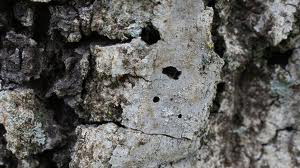
After only about a month, the number of confirmed oaks infested with goldspotted oak borers has surged 20 percent, to 48 from the 40 identified at July’s Mountain Area Safety Taskforce, according to Division Chief Gregg Bratcher, Cal Fire and Riverside County Fire Department forester.
Just as alarming as the rapid spread of the pest is the fear present within the community of seeking help identifying the sick and dying trees.
“I’ve heard from several sources that people don’t want to call the hotline because they’re afraid county fire will come and take the tree or trim it,” Bratcher said.
He emphasized that these actions are not permitted without the permission of the property owner. “We have no jurisdiction without permission,” he stressed.
Many inspections confirm that the oak is not infested with GSOB. In addition, Cal Fire and the Mountain Communities Fire Safe Council are compiling a database of where the infected tress are or were.
Calling the hotline to report a suspicious tree provides valuable data about the current GSOB infestation if the tree truly is infested.
“Any and all data is important to tracking and understanding the pest’s behavior,” Bratcher said. Identifying an infected tree may provide information on how quickly and when the damage is occurring, where are the “hot spots,” as well as how the infestation is moving within the community.
“If the tree is damaged enough to be cut, we’ll send a section to UCR [University of California, Riverside] to analyze it,” he added.
If property owners suspect an oak tree may be infected, They should first visit the UCR’s GSOB site at http://ucanr.edu/sites/gsobinfo/. Then call Cal Fire’s GSOB hotline at 951-659-8328.










